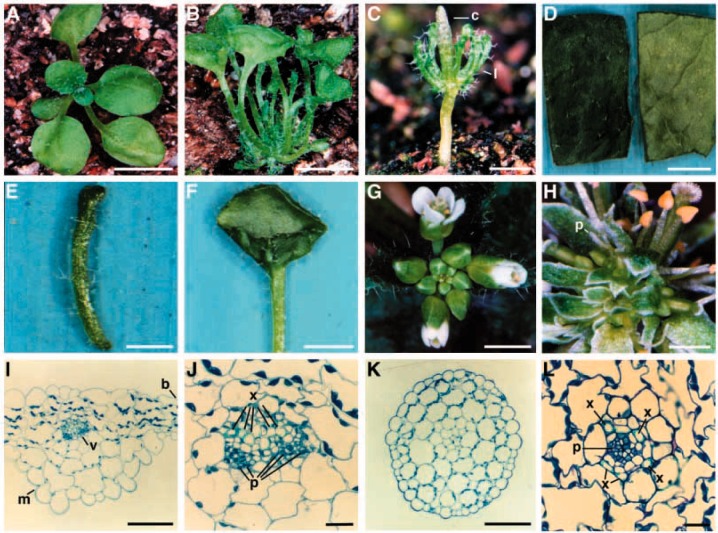Figure 8.
Leaves and floral organs of wild-type and phb-1d mutant of Arabidopsis.(A) Wild-type rosette. Bar, 5 mm.(B) Rosette of phb-1d/+ heterozygote. Note that leaves grow upward, with trumpet-like or rod-like shapes. Bar, 5 mm.(C) Rosette of phb-1d /phb-1d homozygote. Foliage leaves (l) and cotyledons (c) are extremely radialized and grow vertically. Bar, 1.25 mm.(D) Adaxial (left) and abaxial (right) side of a wild-type foliage leaf. The adaxial surface is glossy and dark green whereas the abaxial surface is matte, dull or pale green. Bar, 1.75 mm.(E) Severely adaxialized phb-1d leaf. The glossy, dark-green surface characteristic of the adaxial surface extends around the circumference of the radialized leaf. The petiole is highly reduced. Bar, 1 mm.(F) Less severely adaxialized leaf. This trumpet-shaped leaf exhibits adaxial characters on the outside of the cup. The inside of the cup has abaxial characters. Bar, 1 mm.(G) Wild-type inflorescence. Bar, 2 mm.(H) Inflorescence of phb-1d/+ ; sepals fail to enclose the developing flower (p, petal). Bar, 1.25 mm.(I) Cross section of wild-type foliage leaf at midvein; adaxial surface is up (b, leaf blade; m, midrib; v, vascular tissue). Bar, 100 µm.(J) Magnification of wild-type vascular tissue in midrib (x, xylem; p. phloem). Bar, 20 µm.(K) Cross section of extremely radialized leaf of phb-1d/ + heterozygote. Bar, 100 µm.(L) Magnification of vascular tissue in a moderately radialized phb-1d/ + leaf. Note that xylem cells surround phloem cells. Bar, 20 µm. Photographs are reproduced from McConnell and Barton (1998; Development 125, 2935–2942) with permission.

